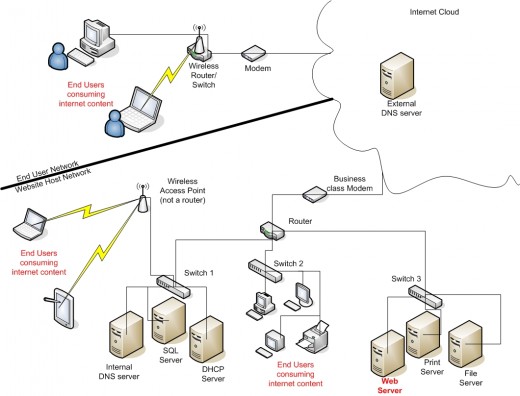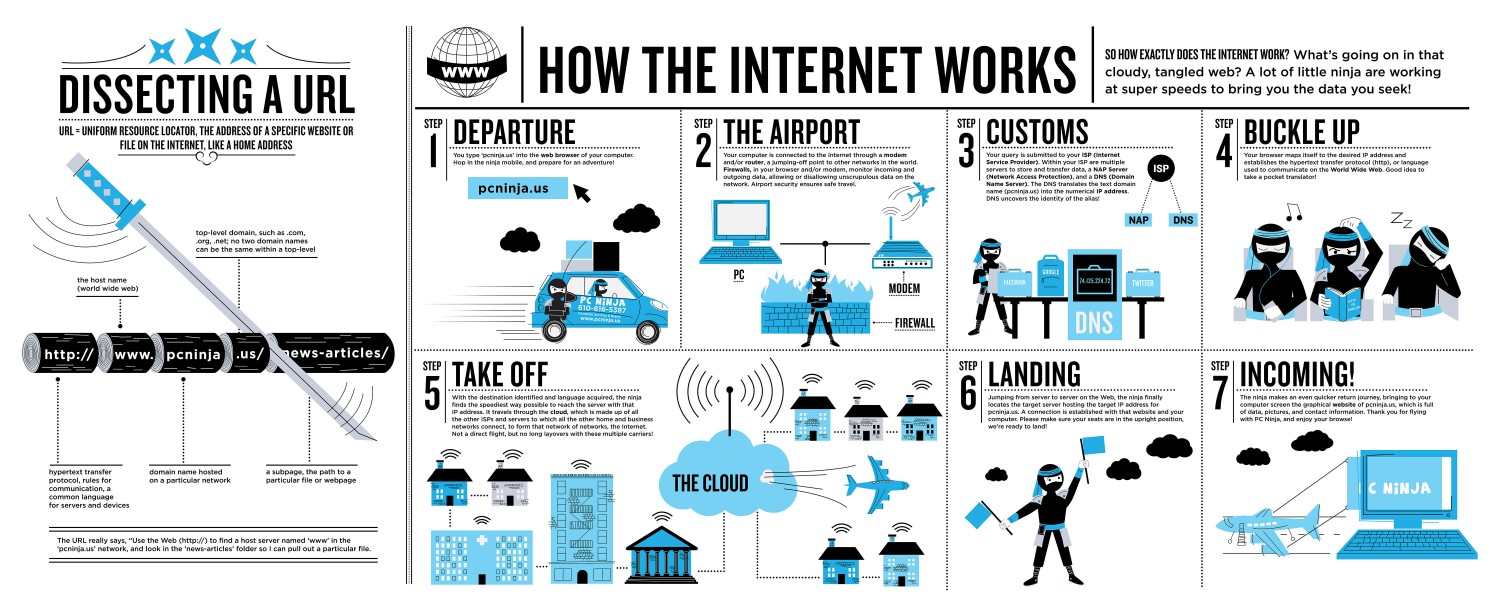How Internet Works?
Date: Feb 15, 2015
Since its beginning in 1969, the Internet has been grown and become most essential part of our lives. However, because everyone knows and uses internet, it doesn't necessarily mean everyone knows how it works.
To understand the Internet, it helps to look at it as a system with two main components. The first of those components is hardware. That includes everything from the cables that carry terabits of information every second to the computer sitting in front of you.

Hardware
It looks much different with phone but it uses the same method. The computer, smartphone or other device you're using to read this may count as one. We call those end points clients. Machines that store the information we seek on the Internet are servers. Other elements are nodes which serve as a connecting point along a route of traffic. And then there are the transmission lines which can be physical, as in the case of cables and fiber optics, or they can be wireless signals from satellites, cell phone or 4G towers, or whatever you name it!
Protocol
Protocols are sets of rules that machines follow to complete tasks. They determines the rules that Internet must follow, communication between devices couldn't happen. The various machines would be unable to understand one another or even send information in a meaningful way. The protocols provide both the method and a common language for machines to use to transmit data.
Two of the most important protocols are the transmission control protocol (TCP) and the Internet protocol (IP). We often group the two together -- in most discussions about Internet protocols you'll see them listed as TCP/IP.
IP Address
You've probably heard of IP addresses. These addresses follow the Internet protocol. Each device connected to the Internet has an unique address. That's called IP address.This is how one machine can find another through the massive network.
When you want to send a message or retrieve information from another computer, the TCP/IP protocols are what make the transmission possible. Your request goes out over the network, hitting domain name servers (DNS) along the way to find the target server. The DNS points the request in the right direction. Once the target server receives the request, it can send a response back to your computer. The data might travel a completely different path to get back to you. This flexible approach to data transfer is part of what makes the Internet such a powerful tool.
Packet
The request will eventually come to our Web server. Our server will respond by sending the requested file in a series of packets. Packets have headers and footers that tell computers what's in the packet and how the information fits with other packets to create an entire file. Each packet travels back up the network and down to your computer. Packets don't necessarily all take the same path -- they'll generally travel the path of least resistance.
If you are interested in reading more about how internet works, check the website out.

Since its beginning in 1969, the Internet has been grown and become most essential part of our lives. However, because everyone knows and uses internet, it doesn't necessarily mean everyone knows how it works.
To understand the Internet, it helps to look at it as a system with two main components. The first of those components is hardware. That includes everything from the cables that carry terabits of information every second to the computer sitting in front of you.

Hardware
It looks much different with phone but it uses the same method. The computer, smartphone or other device you're using to read this may count as one. We call those end points clients. Machines that store the information we seek on the Internet are servers. Other elements are nodes which serve as a connecting point along a route of traffic. And then there are the transmission lines which can be physical, as in the case of cables and fiber optics, or they can be wireless signals from satellites, cell phone or 4G towers, or whatever you name it!
Protocol
Protocols are sets of rules that machines follow to complete tasks. They determines the rules that Internet must follow, communication between devices couldn't happen. The various machines would be unable to understand one another or even send information in a meaningful way. The protocols provide both the method and a common language for machines to use to transmit data.
Two of the most important protocols are the transmission control protocol (TCP) and the Internet protocol (IP). We often group the two together -- in most discussions about Internet protocols you'll see them listed as TCP/IP.
IP Address
You've probably heard of IP addresses. These addresses follow the Internet protocol. Each device connected to the Internet has an unique address. That's called IP address.This is how one machine can find another through the massive network.
When you want to send a message or retrieve information from another computer, the TCP/IP protocols are what make the transmission possible. Your request goes out over the network, hitting domain name servers (DNS) along the way to find the target server. The DNS points the request in the right direction. Once the target server receives the request, it can send a response back to your computer. The data might travel a completely different path to get back to you. This flexible approach to data transfer is part of what makes the Internet such a powerful tool.
Packet
The request will eventually come to our Web server. Our server will respond by sending the requested file in a series of packets. Packets have headers and footers that tell computers what's in the packet and how the information fits with other packets to create an entire file. Each packet travels back up the network and down to your computer. Packets don't necessarily all take the same path -- they'll generally travel the path of least resistance.
If you are interested in reading more about how internet works, check the website out.
